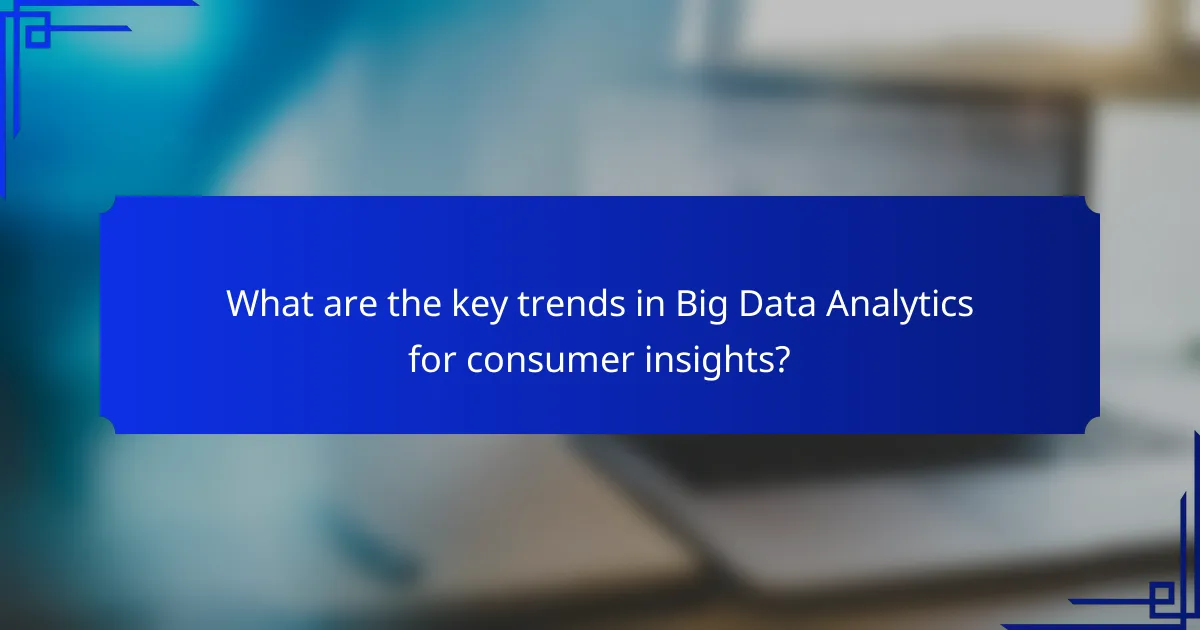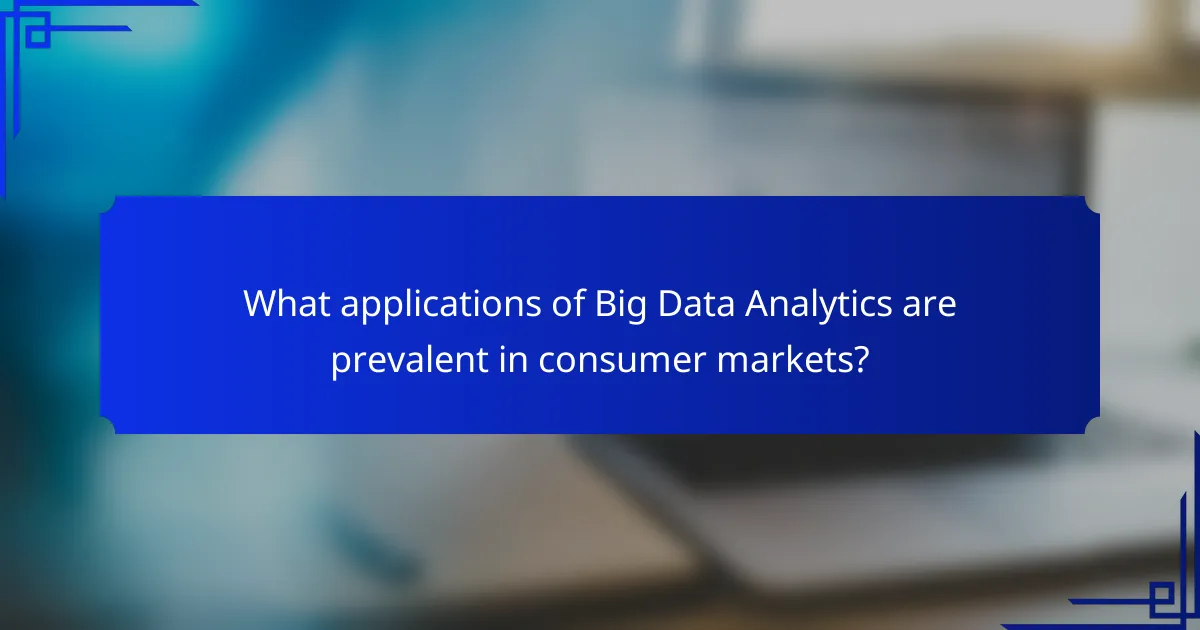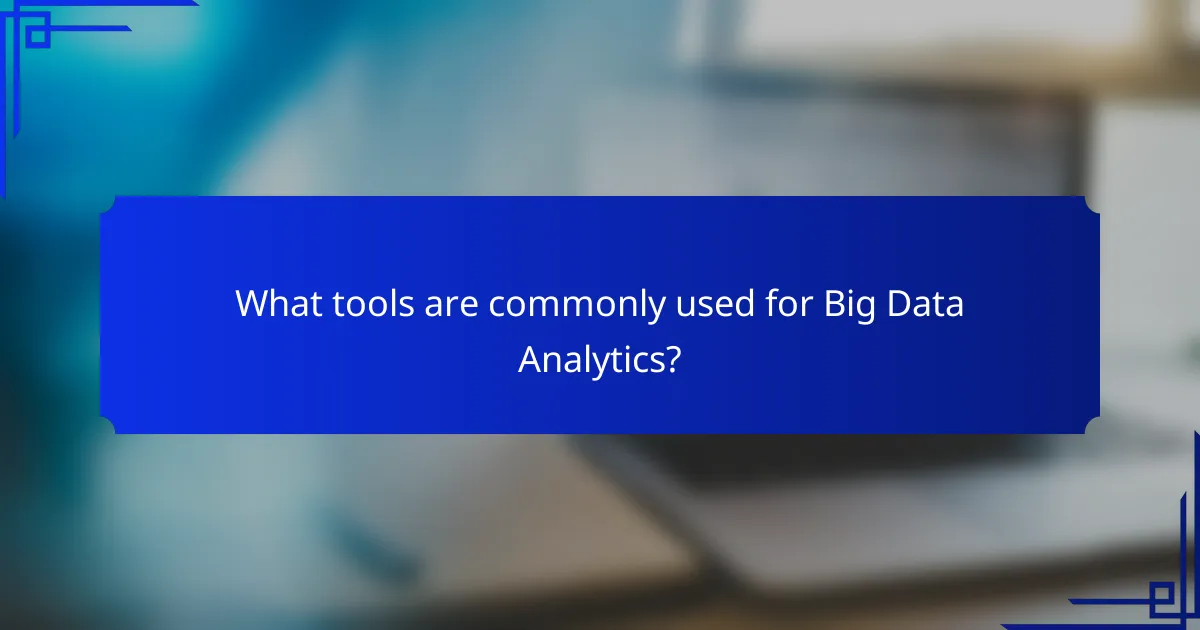Big Data Analytics significantly enhances consumer insights by processing extensive datasets to uncover patterns and trends in customer behavior. This capability empowers businesses to make data-driven decisions, ultimately improving customer experiences and boosting sales. With advancements in real-time data processing, AI, and IoT integration, companies can better understand consumer behavior and tailor their strategies accordingly.

How can Big Data Analytics improve consumer insights?
Big Data Analytics enhances consumer insights by analyzing vast amounts of data to identify patterns and trends in customer behavior. This process allows businesses to make informed decisions that lead to better customer experiences and increased sales.
Enhanced customer segmentation
Enhanced customer segmentation involves dividing a customer base into distinct groups based on shared characteristics, such as demographics, purchasing behavior, and preferences. By utilizing big data, companies can create more precise segments, allowing for targeted marketing efforts.
For example, a retail company might analyze shopping patterns to identify a segment of customers who frequently purchase eco-friendly products. This insight enables tailored promotions that resonate with this specific group, improving engagement and conversion rates.
Predictive behavior analysis
Predictive behavior analysis uses historical data to forecast future consumer actions. By employing algorithms and machine learning, businesses can anticipate what products customers are likely to buy and when they might make a purchase.
For instance, an e-commerce platform can analyze past purchase data to predict that a customer who bought running shoes may soon be interested in athletic apparel. This information allows the company to proactively market relevant products, enhancing the likelihood of a sale.
Personalized marketing strategies
Personalized marketing strategies leverage consumer insights gained from big data to tailor marketing messages and offers to individual preferences. This approach increases the relevance of communications, leading to higher engagement rates.
For example, streaming services often use viewing history to recommend shows or movies that align with a user’s tastes. By providing personalized suggestions, these platforms enhance user satisfaction and retention.

What are the key trends in Big Data Analytics for consumer insights?
Key trends in Big Data Analytics for consumer insights include real-time data processing, increased use of AI and machine learning, and the integration of IoT data. These trends enable businesses to better understand consumer behavior, enhance decision-making, and create more personalized experiences.
Real-time data processing
Real-time data processing allows businesses to analyze consumer data as it is generated, providing immediate insights into trends and behaviors. This capability is crucial for industries like retail and finance, where timely information can significantly impact sales and customer satisfaction.
To implement real-time analytics, companies often use technologies such as Apache Kafka or Amazon Kinesis. These tools help in managing data streams efficiently, enabling organizations to respond quickly to market changes and consumer needs.
Increased use of AI and machine learning
The integration of AI and machine learning in Big Data Analytics enhances the ability to predict consumer behavior and identify trends. These technologies analyze vast datasets to uncover patterns that might not be visible through traditional analytics methods.
For example, retailers can use machine learning algorithms to recommend products based on previous purchases, improving customer engagement and sales. Businesses should consider investing in AI tools that align with their specific goals to maximize the benefits of these technologies.
Integration of IoT data
Integrating IoT data into Big Data Analytics provides a more comprehensive view of consumer interactions and preferences. Devices such as smart home products and wearables generate valuable data that can inform marketing strategies and product development.
Companies should focus on collecting and analyzing IoT data to enhance customer experiences. For instance, a fitness brand might use data from wearable devices to tailor workout plans and product recommendations, fostering a stronger connection with consumers.

What applications of Big Data Analytics are prevalent in consumer markets?
Big Data Analytics plays a crucial role in consumer markets by enabling businesses to harness large volumes of data to drive decision-making and improve customer engagement. Key applications include retail inventory management, customer experience optimization, and dynamic pricing strategies.
Retail inventory management
Big Data Analytics enhances retail inventory management by providing insights into consumer buying patterns and stock levels. Retailers can analyze historical sales data, seasonal trends, and customer preferences to optimize stock levels and reduce excess inventory.
For example, a clothing retailer may use data analytics to predict which items will be in demand during specific seasons, allowing them to stock accordingly. This approach can lead to improved turnover rates and reduced markdowns, ultimately boosting profitability.
Customer experience optimization
In consumer markets, optimizing customer experience through Big Data Analytics involves analyzing customer interactions and feedback across various channels. Businesses can identify pain points and preferences, allowing them to tailor their offerings and improve satisfaction.
For instance, an online retailer might use data to personalize product recommendations based on previous purchases and browsing behavior. This targeted approach can enhance customer loyalty and increase conversion rates, leading to higher sales.
Dynamic pricing strategies
Dynamic pricing strategies leverage Big Data Analytics to adjust prices in real-time based on demand, competition, and customer behavior. This approach allows businesses to maximize revenue by setting optimal prices that reflect market conditions.
For example, an airline may use analytics to increase ticket prices during peak travel seasons while offering discounts during off-peak times. Implementing dynamic pricing requires careful monitoring of market trends and consumer responses to avoid alienating customers.

What tools are commonly used for Big Data Analytics?
Common tools for Big Data Analytics include frameworks and platforms that process large datasets efficiently. These tools help organizations extract valuable insights, visualize data, and support decision-making processes.
Apache Hadoop
Apache Hadoop is an open-source framework designed for distributed storage and processing of large datasets across clusters of computers. It uses a simple programming model and allows for the handling of vast amounts of data in a cost-effective manner.
Key components of Hadoop include the Hadoop Distributed File System (HDFS) for storage and MapReduce for processing. Organizations often choose Hadoop for its scalability and ability to work with various data types, making it suitable for big data applications.
Tableau
Tableau is a powerful data visualization tool that enables users to create interactive and shareable dashboards. It connects to various data sources, allowing for real-time data analysis and visualization, which is essential for deriving consumer insights.
With its user-friendly interface, Tableau facilitates the exploration of data through drag-and-drop features. Businesses often use Tableau to identify trends and patterns quickly, making it easier to present findings to stakeholders.
Google BigQuery
Google BigQuery is a fully-managed data warehouse that allows for super-fast SQL queries and analysis of large datasets. It is designed for scalability and can handle petabytes of data, making it ideal for organizations with extensive data needs.
BigQuery’s serverless architecture means users do not need to manage infrastructure, allowing them to focus on analytics. It integrates well with other Google Cloud services, making it a popular choice for businesses looking to leverage cloud capabilities for big data analytics.

What criteria should businesses consider when choosing Big Data Analytics solutions?
Businesses should consider scalability, integration capabilities, and user-friendliness when selecting Big Data Analytics solutions. These criteria ensure that the chosen platform can grow with the business, seamlessly connect with existing systems, and be easily utilized by team members.
Scalability of the platform
Scalability refers to a platform’s ability to handle increasing amounts of data and users without sacrificing performance. Businesses should look for solutions that can efficiently manage data growth, whether it’s from expanding customer bases or increasing data sources.
A scalable analytics solution should support both vertical and horizontal scaling. For example, it should allow for adding more powerful servers or distributing data across multiple servers as needed. This flexibility can help businesses avoid costly migrations to new systems as their data needs evolve.
Integration capabilities
Integration capabilities are crucial for ensuring that a Big Data Analytics solution can work with existing software and data sources. A platform that easily connects with Customer Relationship Management (CRM) systems, databases, and other tools can streamline data flow and enhance insights.
When evaluating integration options, businesses should consider whether the solution supports common data formats and APIs. A good practice is to choose platforms that offer pre-built connectors or robust integration frameworks, which can significantly reduce implementation time and complexity.
